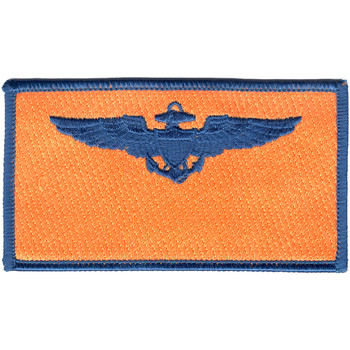Description
Naval Aviator Pilot Wings Patch Gold (U.S. Navy) 4.0" x 1.5" Embroidered Patch with Iron-On Backing
Superior Materials: Made with premium polyester thread and durable twill fabric, ensuring long-lasting color and strength.
Advanced Embroidery Technology: Crafted using the most advanced embroidery machinery, guaranteeing intricate detail, sharp lines, and consistent quality every time.
Easy Iron-On Application: Features a heat-activated adhesive backing for quick, no-sew attachment. Simply position, iron, and press for a secure bond.
Versatile Use: Perfect for personalizing jackets, backpacks, uniforms, or any fabric surface that needs a touch of personality.
Durable and Washable: Designed to withstand everyday wear and occasional washing without fading or fraying.
Formations & Origins
The Naval Aviator Pilot Wings Patch, often called “Wings of Gold,” traces its roots back to 1917, during the infancy of U.S. naval aviation. At the time, America was entering World War I and realizing the strategic importance of aircraft launched from the sea. With early aviation becoming formalized within military ranks, the Navy created a unique emblem to designate those who completed its rigorous flight training.
The insignia combined three powerful symbols: a central shield representing defense of the nation and naval service, a fouled anchor symbolizing maritime tradition, and golden wings denoting flight. From the start, it was a mark of distinction — not issued lightly, and only earned through perseverance and excellence.
Notable Commanders
Although the Wings themselves are not a unit, they're carried by generations of elite naval leaders and heroes. Among the most revered:
Vice Admiral James Stockdale – A fighter pilot shot down over Vietnam in 1965. He endured over seven years in captivity and emerged a national hero, receiving the Medal of Honor for his leadership and defiance in enemy hands.
Commander John McCain – Another Vietnam-era pilot shot down and held in Hanoi for over five years. While his political career later took center stage, his reputation as a tough, resilient aviator was forged in the skies.
Captain Rosemary Mariner – One of the first women to earn her Wings of Gold and the first female aviator to command an operational squadron. A trailblazer who opened the door for future generations of women in naval aviation.
Major Campaigns/Operations
Naval aviators have flown in every major conflict since World War I, but their combat legacy became legend in World War II:
Battle of Midway (1942) – Carrier-based dive bombers from USS Enterprise, Yorktown, and Hornet changed the course of the Pacific War in a single morning by sinking four Japanese carriers. It was a defining moment for naval aviation.
Korea and Vietnam – Carrier aviation became the central pillar of U.S. airpower. Aviators flew countless sorties from the sea, including high-risk missions over North Vietnam to destroy enemy infrastructure and engage Soviet-built MiGs.
Desert Storm (1991) – F/A-18 Hornets and A-6 Intruders launched from carriers like USS Saratoga pounded Iraqi positions with precision. Naval aviation proved it could strike deep into enemy territory from international waters.
Global War on Terror – Pilots flying F-14 Tomcats, F/A-18 Super Hornets, and now F-35Cs have conducted combat air patrols, close air support, and ISR (intelligence, surveillance, reconnaissance) missions over Iraq, Afghanistan, Syria, and beyond.
Specialized Role/Equipment
Naval aviators hold one of the most technically demanding jobs in the military. They're trained to operate off aircraft carriers — mobile, pitching airfields at sea — often in total darkness and during combat.
Training includes:
Carrier qualifications (CATOBAR launches and arrested landings)
Aerial combat (dogfighting and missile engagements)
Ground attack and strike tactics
Airborne command and control
Night flying and low-visibility navigation
Aircraft flown by naval aviators have included the F6F Hellcat, F4U Corsair, A-4 Skyhawk, F-14 Tomcat, F/A-18 Hornet, and today’s stealth-capable F-35C Lightning II.
Acts of Heroism
LCDR Edward "Butch" O’Hare – In February 1942, he singlehandedly attacked a formation of nine Japanese bombers en route to strike his carrier. He downed five in minutes, becoming the Navy's first WWII ace and Medal of Honor recipient. Chicago's O'Hare Airport bears his name.
LCDR Michael Estocin – A Vietnam-era A-4 pilot who flew deep into enemy territory on multiple SAM-suppression missions. Hit by ground fire, he pressed his attack to protect his wingmen. He never returned. Posthumously awarded the Medal of Honor.
LT Tom Hudner – During the Korean War, Hudner crash-landed his aircraft intentionally to try and save fellow pilot Jesse Brown, the Navy's first African-American aviator, who had been shot down behind enemy lines. Hudner received the Medal of Honor for his bravery.
Legacy & Notable Achievements
The Wings of Gold have come to symbolize more than just flight qualification. They represent an elite fraternity of warriors trained to project American power across the globe from the deck of a carrier.
Naval aviators have:
Earned over 300 Medals of Honor, Navy Crosses, and Distinguished Flying Crosses
Landed more than 20 million arrested carrier landings since WWII
Supplied the backbone of America’s space program — more than 150 naval aviators have become NASA astronauts, including Neil Armstrong
Created a culture of excellence that is still the envy of global military aviation forces
To those who wear them, the Wings of Gold are not just a patch — they’re a lifelong mark of achievement. They’re earned with sweat, courage, and no small amount of danger. And they are worn with pride from the cockpit to the grave.







